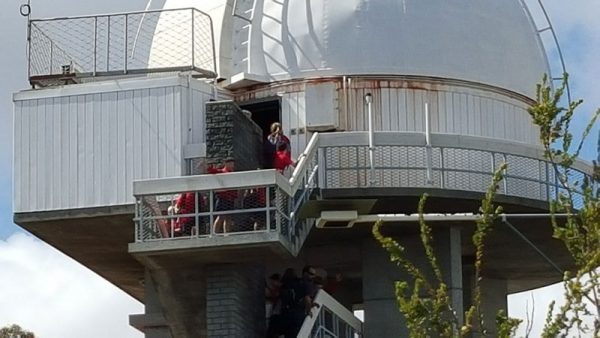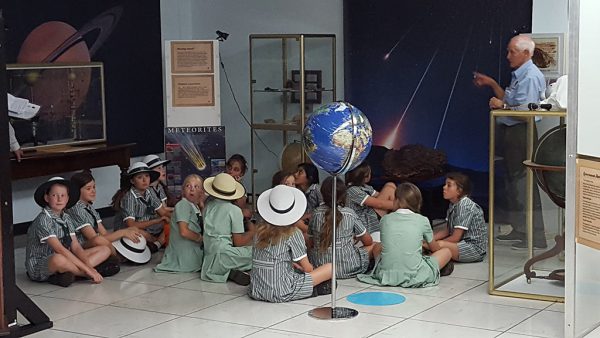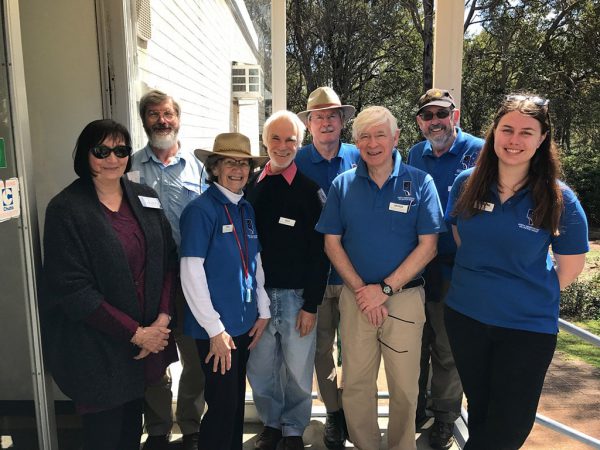Getting our kids hooked on space and astronomy
Do you remember being 8 years old and knowing that you were destined to do great things when you grew up? You were going to be an Astronaut, a Truck Driver, the greatest Superhero of all time, a Brain Doctor and –if you were really lucky–a Petrol Pump Attendant or Ice-cream Seller! The world was at your feet and anything was not only possible but probable. And do you remember those special people in your life who encouraged those dreams? Made the capes, helped build the spaceship cubby in the bush, let you ‘operate’ on them time and again, and who took the time to just look in the sky with you and point out the stars?
There were also those people who would take the time to answer your questions, teach you to see what was around you and explain how it works and why. Special fun people just like those in our School Day Tours Team
So how does a School Day Tour work?

A school contacts Perth Observatory through the website by going to the Tours section and clicking on School Day Tours. They then fill out the request form and select the activities that they would like to do. Our School Day Tour team then organise with the school and our volunteers the best time to suit everyone. Our volunteers have guidelines to follow for each activity that follows the Australian National Curriculum. They make sure they are totally familiar and comfortable with their topic, then give it their own distinct spin to keep the children excited and engaged. There’s always some laughter mixed in with the ‘awwws’ and ‘wows’. Each activity is just that, a hands-on activity. The children learn about a concept and actively do or make something that helps explain the concept. It’s a lot of fun and very interactive.
On the day of the Tour, the school group will often start their outing with morning tea on the back lawn. It’s always surprising how many children haven’t seen a kangaroo before or even been in a state forest. After a welcome chat and a reminder to ignore the kangaroo poo and to keep to the paths, the children are divided into groups to start their fun. A tour can have between 3 and 6 activities, with a volunteer presenting each activity. The groups rotate around the activities, have lunch back on the lawn (no, the kangaroos aren’t to be patted) and if staying for the day return to their bus at about 2 pm. This is when our trusty volunteers stagger into the kitchen for a much-needed coffee and a few giggles about some of the funny comments they’ve had. One of my favourites was from Matt R: ‘Today as part of a school visit, I showed a picture of Omega Centauri.”
This is the oldest thing you will ever see. It is over 13 billion years old”. Student: “Is that why it is in black and white?”‘. There’s always a genius child and one that after some coaxing ends up being more excited than the rest. The most rewarding part, of course, is seeing the children leave with stars in their eyes and desperately excited to tell their family about everything they’ve seen and learnt.
What are some of the activities?

All our tours are organised to suit groups of children aged between 7 and 12 and cover a wide variety of topics including:
- Astrographic Telescope Dome – How did Astronomers take photos of the stars in the old days
- Lowell Telescope Dome – Climb up the stairs and learn about ground breaking research done here including mapping the weather on Mars, Jupiter and the co- discovery of the rings around Uranus. Then learn about gravity and craters by dropping different sized meteorites (rocks) off one of the landings into a container of sand – but don’t hit the dinosaurs!
- Meteorites and the Moon – Touch a real meteorite and learn about moon phases and the seasons.
- Shadows and Sundials – Explore shadows and learn how to use a sundial. Some children have not seen a sundial before and have no idea what it is used for.
- Solar Telescope Dome – Have you seen a sunspot? How about a solar flare?
- Sun Earth and Moon – How do the Sun, Earth and Moon move around each other and why?
- Sunshine and Rainbows – How do you make a rainbow? What colour is sunlight?
- Survival on the Moon – Your space-shuttle has crashed, what will you need to survive on the Moon?
Do you have to be an Astronomer or Teacher to be a School Day Tour Volunteer?
No, but it helps! We train all our volunteers through our mentoring program. They are all experienced in dealing with children, have current Working With Children cards, are fascinated with science, have a good sense of humour and simply enjoy getting children excited about science, telescopes and history.
Are there School Day Tours in the holidays?
Yes! But we call them Parent/Child Tours. They are extra special as the parent or caregiver attends with the child and whilst the child is doing activities, the adult gets a Guided Tour of the telescopes and learns about our history. At this stage there is only one tour per school holiday and bookings can be made on the website.
How long have the School Day Tours been running?

School day tours have been running for many years, but, a School Day Tours sub-committee was formed in 2012 to review and update the activities. It wasn’t until 2014, after years of research that the first new-style tour was trialled. Unfortunately, soon after, funding for the Observatory was cut and the program was cancelled. The remaining members of the School Day Tour team, Chris Coulstock and Arthur Harvey refused to give up and in 2015 got the program running again. Within a year, School Day Tours had exceeded expectations successfully running a number of tours for children from Port Hedland to Mandurah, Subiaco to Kingsley. This number has since doubled for 2017 with up to 3 tours being held in a week. The activities are mostly written by a retired school teacher and Doctor of Education Chris Coulstock, with ideas and inspiration from Matt Robertson, Arthur Harvey and Hubert Rady – all popular presenters on the tours.
‘Children need it to be exciting’ says Chris and it is! The feedback has been overwhelmingly positive with schools booking again for the next year. The smiles on the children’s faces as they leave, say it all.
Any future plans?
The Tours are constantly evolving to be their absolute best with many ideas for new activities being looked at. Eventually, there is hope for a special program for Year 7 and 8’s set late in the day with hands-on activities followed by a short star viewing session; and a hands-on activity for younger children that culminates in a moon-viewing session through a telescope.
Being a part of the School Day Tours Team is your chance to be one of those special people that inspire a child to look beyond what is immediately around them. To explore and challenge ideas and to learn that anything really is possible. It’s humbling to see them realise how amazing it is to be part of this truly spectacular universe.





